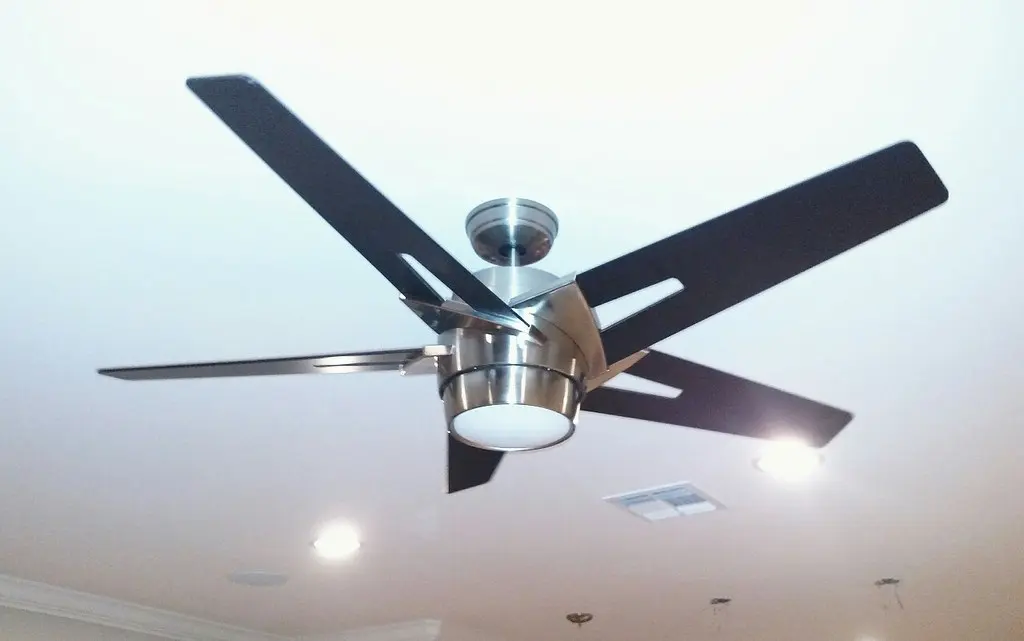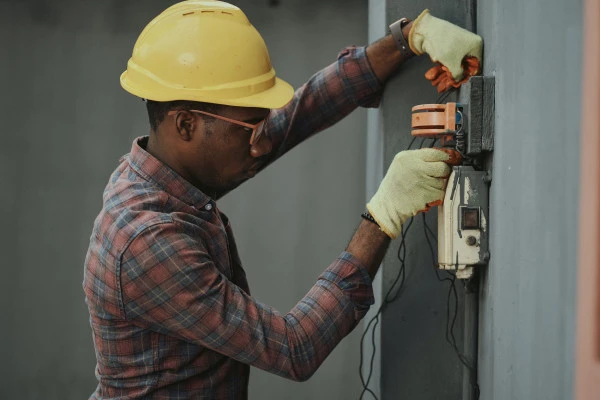How Much Does Ceiling Fan Installation Cost?

Ceiling fans are essential fixtures offering functionality and aesthetic appeal to spaces. They can cool rooms, circulate air, and even serve as a light source. But the million-dollar question is, how much does it cost to have one installed? The answer varies depending on several factors.
Types of Ceiling Fans
- Standard ceiling fans are your essential fans without bells and whistles. They typically have a straightforward design and are meant for normal ceiling heights.
- Low-profile ceiling fans: Hugger fans, designed for rooms with lower ceilings, are also known by this name.
- Energy-efficient ceiling fans: These fans use less electricity and aim for better environmental friendliness.
- Ceiling fans with lights: These have integrated light fixtures, combining two utilities.
- Outdoor ceiling fans: These fans, specially designed for outdoor use, can withstand weather conditions.
Factors Influencing Cost
- Size and Type of the Fan: Installation of more giant fans or those with additional features can be more labor-intensive.
- Location of Installation: The height of the ceiling, whether outdoors or indoors, can change the complexity of the installation.
- Existing Electrical Wiring: The installation could be cheaper if a room already has wiring in place. Conversely, setting up new wiring will drive up costs.
- Labor Rates: You might pay different rates depending on the region or the electrician’s expertise.
- Additional Features and Accessories: Features like remote controls or special blades can sometimes increase installation time and costs.
Average Cost Breakdown
1. DIY Installation:
- Ceiling fan: $50 - $300
- Tools and materials: $20 - $50
2. Professional Installation:
- Base labor costs: $100 - $250
- Hourly rates: $50 - $100/hour (usually takes 2-4 hours if wiring exists)
- Additional charges for electrical upgrades or unique mounts: $50 - $200
Table: Installation Cost by Type
| Fan Type | Average Fan Cost | Installation Cost |
|---|---|---|
| Standard | $75 - $200 | $100 - $250 |
| Low-profile | $60 - $180 | $100 - $250 |
| Energy-efficient | $100 - $300 | $120 - $275 |
| With lights | $100 - $350 | $120 - $275 |
| Outdoor | $150 - $400 | $150 - $300 |
3. Hidden Costs:
- Ceiling repairs: $50 - $150
- Electrical upgrades: $100 - $500
- Permits (if required): $50 - $100
Benefits of Hiring a Professional
- Expertise and Experience: A professional will know the ins and outs of installation, ensuring the job is done right.
- Safety: Working with electrical fixtures can be risky. A professional will know the safety protocols.
- Assurance: Many professionals offer a warranty on their work, ensuring peace of mind.
- Potential Warranty on Work: If something goes wrong, they must fix it.
Tips to Save on Installation Costs
- Shop during sales or off-season: Post-summer or during significant sale events can be ideal.
- Consider DIY: If you're confident in your skills, you could save on labor costs.
- Get multiple quotes: Shopping around and getting the best deal is always good.
- Package deals: Some retailers offer installation as a bundled service when you buy the fan from them.
How to Calculate Ceiling Fan Installation Cost: A Formulaic Approach
Understanding the different factors influencing ceiling fan installation costs can be beneficial. Here's a simple formulaic approach to calculate an estimate for the installation:
Formula:
Total Installation Cost = Fan Cost + Labor Cost + Additional Features & Accessories Cost + Hidden Costs
Breakdown:
- Fan Cost (FC): This is the cost of the fan itself. Depending on the type, this can vary.
- Standard: $75 - $200
- Low-profile: $60 - $180
- Energy-efficient: $100 - $300
- With lights: $100 - $350
- Outdoor: $150 - $400
- Labor Cost (LC): This can vary depending on whether you have existing wiring and your region. Typically calculated based on hourly rates or a flat fee.
- Existing wiring: $100 - $250
- No existing wiring (requires additional time): $200 - $450
- Additional Features & Accessories Cost (FA): If you’re adding on remote controls, special blades, or light fixtures.
- Average range: $20 - $150
- Hidden Costs (HC): These are costs you might not immediately consider, such as repairing the ceiling, upgrading electrical circuits, or obtaining necessary permits.
- Ceiling repairs: $50 - $150
- Electrical upgrades: $100 - $500
- Permits: $50 - $100
The calculation might look something like this when you use the formula:
Total Installation Cost = FC + LC + FA + HC
Example Calculation:
Suppose you're installing a standard ceiling fan in a room without wiring. You've also chosen a remote-controlled fan that costs an additional $50.
- Fan Cost (FC) = $150
- Labor Cost (LC) = $350 (since there's no existing wiring)
- Additional Features & Accessories Cost (FA) = $50
- Hidden Costs (HC) = $100 (including minor ceiling repairs and permits)
Total Installation Cost = $150 + $350 + $50 + $100 = $650
Thus, in this example, the estimated cost of installing the ceiling fan would be $650.
FAQ: Ceiling Fan Installation Cost
1. How much does a standard ceiling fan installation cost?
The cost of installing a standard ceiling fan ranges from $150 to $500, depending on labor costs, existing wiring, and additional features.
2. Can I install a ceiling fan by myself?
If you have the necessary tools and skills, you can install a ceiling fan yourself. However, for safety reasons and correct installation, especially when dealing with electrical wiring, hiring a professional is recommended.
3. How does the height of my ceiling affect installation costs?
Higher ceilings often require additional equipment, such as ladders or scaffolding, and may take more time to install, leading to higher labor costs. On the other hand, standard or low-profile ceilings typically have more straightforward installation processes.
4. Do I need to pay extra for a fan with a lighting fixture?
Ceiling fans with integrated lighting fixtures may cost slightly more initially. The installation could also be more complex, leading to increased labor costs. Always check with your installer for an accurate quote.
5. How much would electrical upgrades add to the installation cost?
Should your home need electrical enhancements for a safe fan installation, you might see a price rise ranging from $100 to $500 based on the upgrade's intricacy.
6. Is there a difference in installation cost between indoor and outdoor fans?
Outdoor fans can withstand external conditions, and installing them might require extra precautions, which can lead to a slight cost increase. Always ensure that the fan you choose is appropriate for its intended location (indoor vs. outdoor).
7. What are some hidden costs I should be aware of?
Some potential hidden costs include ceiling repairs, electrical upgrades, or necessary permits. It's advisable to discuss all possible expenses with your installer upfront.
8. How can I save on installation costs?
Some ways to save money include shopping during sales, considering a DIY approach (if confident), obtaining multiple professional quotes to compare, and looking for package or bundled deals.
9. Do all installations require a permit?
Not all installations require a permit, but checking local regulations is essential. Some regions may require permits, especially if there's significant electrical work involved.
10. How long does it typically take to install a ceiling fan?
For a professional, installing a ceiling fan in a room with pre-existing wiring typically takes 2-4 hours. However, if new wiring or other complications are required, it might take longer.
Questions to Ask When Evaluating Ceiling Fan Installation Companies
When considering a company to handle your ceiling fan installation, gathering as much information as possible is essential to ensure you choose the right professionals for the job. Here are some questions to guide your decision-making process:
1. Licensing and Insurance:
- Are you licensed to perform electrical installations in this state/region?
- Do you carry insurance, and what does it cover?
- Can you provide proof of both license and insurance?
2. Experience and Expertise:
- How long have you been in the ceiling fan installation business?
- What types of ceiling fans are you most experienced installing (standard, low-profile, outdoor, etc.)?
- Do you have any specialized training or certifications?
3. Costs and Estimates:
- Do you offer free estimates for the installation?
- What does the installation fee cover? Are there any potential hidden costs I should be aware of?
- Do you provide any work warranties or assurances?
4. Procedures and Protocols:
- How long will the installation process typically take?
- Will I need to prepare anything before the installation?
- How do you handle unexpected complications or costs during the installation?
5. References and Reviews:
- Can you provide references or testimonials from past clients?
- Are there online reviews or ratings available for your company?
6. Materials and Equipment:
- Do you provide the ceiling fans, or must I purchase them separately?
- What brands or types of fans do you recommend or work with most often?
- Do you use any specialized equipment during the installation?
7. Post-Installation:
- What post-installation services do you offer, if any (like maintenance or repair)?
- What should I do if there's an issue with the fan after installation?
- How can I best maintain and care for my new ceiling fan?
8. Deals and Discounts:
- Do you offer any promotions, discounts, or package deals for installations?
- Is there a discount if I install multiple fans simultaneously?
9. Scheduling and Availability:
- How soon can you schedule the installation?
- Do you work on weekends or outside regular business hours?
By posing these questions, you can select a ceiling fan installation company that matches your requirements, budget, and desired outcomes more effectively. Always compare answers from different companies to make the most informed decision.
The price of installing a ceiling fan fluctuates based on different elements. However, whether you choose DIY or professional installation, the benefits of having a ceiling fan – like improved air circulation, added comfort, and energy savings – make it a worthwhile investment.
The opinions articulated in this piece are the guest author's and may not necessarily align with those of Crackerjack. Find more about staff authors of Crackerjack

